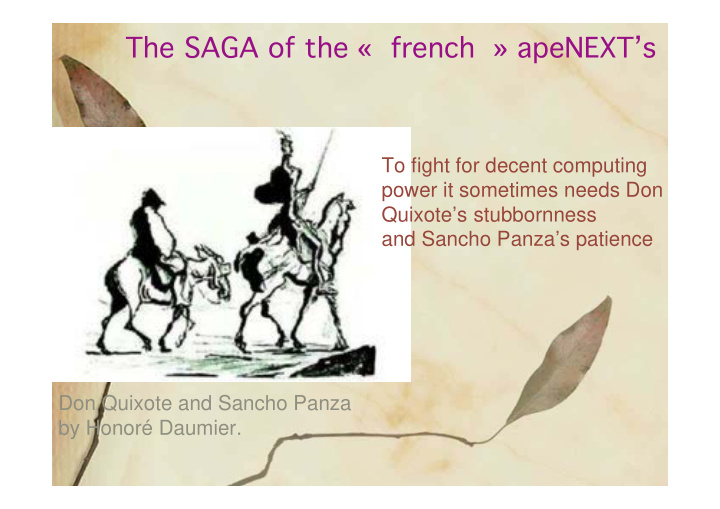



The SAGA of the « french » apeNEXT’s To fight for decent computing power it sometimes needs Don Quixote’s stubbornness and Sancho Panza’s patience Don Quixote and Sancho Panza by Honoré Daumier.
Dulcinea del Toboso
We discovered a collaboration full of Don Quixote’s These poeple were simply conceiving and developing from scratch (well, let’s say, from APEmille), at dawn of the 21st century, on the european continent, practically void of computer industry, a Teraflop computer !!! We did not hesitate one second, we asked to join The apeNEXT collaboration
These people were not beginners, they had already developed three generations of APE The tribes were located in Pisa/Ferrara, Roma, Zeuthen/Berlin, later joined by the teutonic knights from Bielefeld. There was a huge amount of wind mills to defeat
E pur si muove ! E pur si muove And yet apeNEXT runs ! Provided they don’t deliver bad chips
We have brought our modest contribution to apeNEXT R&D: Unexpert contribution from LPT (Orsay) to the tests. CAPS group of IRISA/INRIA (Rennes): creates « SOFAN », code optimizer for the ApeNext system, developed in In collaboration with Zeuthen and Pisa/Ferrara SOFAN (Software Optimizer for ApeNEXT) — is designed as a flexible middle-end optimizer for apeNEXT. Operating on the level of assembly code it performs various analyses coupled with a set of standard and target-dependent optimizing transformations, that address specific features of the J&T chip architecture. SOFAN attempts to remove low-level code slackness left over by the code generation process of the front-end compilers (nlcc, rtc). The optimizer is based on SALTO framework.
We then needed funding to buy apeNEXT We went to the funding institutions: Département scientifique Mathématiques, physique, planète et univers IN2P3/CNRS A N R Dapnia
Notwithstanding the support of several high rank scientific directors It took four years in a kafkaesque labyrinth To get one rack funded by ANR and another by CNRS (MPPU/IN2P3) Not yet delivered
They will be located in the university Roma La Sapienza (thanks to Roma-I and INFN) What to be done with these two racks ? One preliminary remark: two racks are not enough for an unquenched calculation according to modern standards; collaborations are necessary and welcome
Flavor physics; QCD in the IR; Nucleon, ● LPT-Orsay, CPhT Polytechnique, SPhN Saclay Nucleus (Yukawa) Nucleon, LPSC Grenoble Flavor physics; Overlap; nucleon CPT Marseille
The scientific projects concerning flavor physics and nucleon physics do need dynamical quarks. Lattice flavor physics, beauty, charm, strangeness has been studied since long. Several retirements are closing up, but a younger generation is present in Orsay and Marseille. Newcomers from nuclear and hadronic physics are joining (Grenoble and Saclay)
Program on charm physics Orsay ● New strategies for a precision calculculation of weak matrix elements on the lattice with Wilson quarks: K →π µ ν , D →π µ ν transition form factors ● Towards a handle on weak annihilation matrix elements in B-decays, and computation of Δ F=2 and Δ B=2 operators
• Combining theory and experiments: from D's to B's ● Electromagnetic properties of hadron interactions on the lattice (light → light and heavy → heavy meson transitions) Regular discussions about charm form factors with experimentalists of the BABAR group who perform high statistics measurements
Marseille’s group will pursue its program on flavor physics using overlap quarks. TAO language is an obstacle to using apeNEXT. A C-compiler is requested there. u and d quark wave function in a Λ -like state s-quark being at z=1.8a
Twisted quarks and ETMC collaboration Collaboration of lattice groups in Italy, Germany, Spain, UK, France Has produced more than 25000 N f =2 trajectories down to masses lower than 300 MeV for the pion. Wide program of physics To be described by Karl Jansen
Nucleon physics The nucleon constitute the majority of the visible matter of the universe. Yet it is not so well known as one would expect There is an intensive experimental activity: Jefferson-lab, GSI (Darmstadt), CERN (COMPASS) etc.
One example: Electric and magnetic form factors of the proton Is this due to two photons exchange, To radiative corrections ?
Many additional mysteries What is the strange content of the nucleon ?the strange magnetic moment ? What fraction of the nucleon spin is borne by the quarks, what is the orbital momentum of the quarks ? Why is the positive parity Roper resonance (1440 MeV) lighter than the negative parity (1535 MeV) ? Can one explain from first principles the nucleon interaction in nuclei ? And many other questions which you don’t even dare to ask !!! And many more you cannot answer with lattice
β =3.9, µ =0.0085 β =3.9, µ =0.0064
Recommend
More recommend